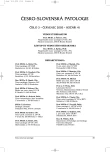Mammary gland development and cancer
Prsní žláza – vývoj a nádory
Prsní žláza je komplexní orgán, jehož vývoj začíná záhy v gestaci, a který se od puberty k menopauze průběžně mění ve velikosti, tvaru i funkci. Zatímco nejčasnější stadia embryogeneze probíhají nezávisle na steroidních hormonech, po 15. týdnu je struktura prsu významně ovlivněna řadou hormonů. U většiny žen začíná po pubertě další vývoj prsu pod vlivem cyklické sekrece estrogenu a progesteronu. Tento proces může pokračovat i po dvacítce a je potencován těhotenstvím. Růstové a transkripční faktory přispívají ke vzájemným interakcím stroma – epitel při růstu vývoji normální prsní žlázy, i při patogenezi. Z pohledu embryologie vychází morfologie duktálních i lobulárních buněk prsu z téhož vývojového procesu. Existují četné údaje o existenci obnovujících se pluripotentních kmenových buněk prsní žlázy, avšak jejich molekulární charakteristika a cesty diferenciace nejsou dosud známy. Lze doufat, že probíhající rozsáhlý výzkum molekulární biologie, patologie a nádorové genomiky a proteomiky přispěje k objasnění všech genetických i zevních faktorů účastnících se vývoje, diferenciace a involuce prsní žlázy, a zároveň povede k lepšímu pochopení etiopatogeneze, časnému záchytu, léčbě a možná i prevenci karcinomu prsu.
Klíčová slova:
prsní žláza – vývoj – diferenciace – růstové faktory – transkripční faktory – duktální a lobulární buňky – karcinom prsu
Authors:
G. Turashvili 1; J. Bouchal 1; G. Burkadze 2; Z. Kolar 1
Authors‘ workplace:
Laboratory of Molecular Pathology and Institute of Pathology, Palacky University
Olomouc, Czech Republic
1; Department of Pathology, Tbilisi State Medical University, Tbilisi, Georgia
2
Published in:
Čes.-slov. Patol., 41, 2005, No. 3, p. 94-101
Category:
Original Article
Overview
The mammary gland is a complex organ that begins development early in gestation and constantly changes in size, shape and function from the time of puberty to menopause. The earliest stages of embryogenesis appear to be independent of steroid hormones, whereas after the 15th week breast structure is largely influenced by a variety of hormones. In most females, further breast development begins at puberty under the influence of cyclical estrogen and progesterone secretion. This process may continue into the 20s and it is enhanced by pregnancy. Growth and transcription factors contribute to the reciprocal stromal-epithelial interactions in growth, development and tumorogenesis of the mammary gland. From the embryological point of view the morphology of both mammary ductal and lobular cells results from the same developmental process. Numerous data suggest the existence of self-renewing, pluripotent mammary stem cells but their molecular characteristics and differentiation pathways are unknown. The extensive research currently being done in molecular biology and pathology, cancer genomics and proteomics will hopefully contribute to further elucidation of all the genetic and environmental factors involved in the development, differentiation, and involution of the mammary gland and this may give insight into the etiopathogenesis, early detection, treatment, and potential prevention of breast cancer.
Key words:
mammary gland development – differentiation – growth factors – transcription factors – ductal and lobular cells – breast cancer
Labels
Anatomical pathology Forensic medical examiner ToxicologyArticle was published in
Czecho-Slovak Pathology

2005 Issue 3
Most read in this issue
- Mammary gland development and cancer
- Emphysematous Cystitis due to Clostridium perfringens - a Localised Infection in a Man with Generalized Melanoma
- Adenomatoid Tumor of the Right Adrenal Gland: A Case Report
- Immunohistochemical Study of the Apoptotic and Proliferative Mechanisms in the Intestinal Mucosa During Coeliac Disease
